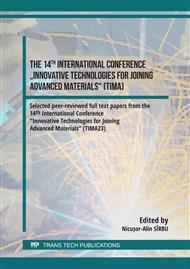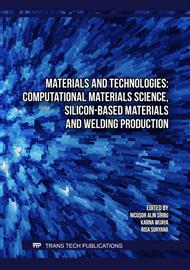[1]
Key figures on European business, 2023 edition, 25 May 2023, https://ec.europa.eu/eurostat/en/web/products-key-figures/w/ks-04-23-195
Google Scholar
[2]
The Green Deal Industrial Plan, https://commission.europa.eu/document/41514677-9598-4d89-a572-abe21cb037f4_en, Accessed in April (2023)
Google Scholar
[3]
Kapil, A., Moinuddin, S.Q., Sharma, A. (2022). Digitization of welding processes, Woodhead Publishing Reviews: Mechanical Engineering Series, Joining Processes for Dissimilar and Advanced Materials, Woodhead Publishing, Pp. 483-512, ISBN 9780323853996
DOI: 10.1016/B978-0-323-85399-6.00020-5
Google Scholar
[4]
Discover Welding 4.0 and Uncover the Benefits of Automation, https://indusuite.com/eds_en/blogs/welding-40-is-here-and-this-is-what-you-need-to-know-about-it1/
Google Scholar
[5]
How to Use Data to Optimize Your Company's Welding Process. 5 Ways WeldCloud Can Help You Grow, https://indusuite.com/eds_en/articles/how-to-use-data-to-optimize-your-companys-welding-process/, Accessed in May (2023)
Google Scholar
[6]
Welding 4.0 Quality Management System with Digitalisation, https://sws.org.sg/news/welding-4-0-quality-management-system-with-digitalisation/, Accessed in April (2023)
Google Scholar
[7]
Kah, P., Suoranta, R. & Martikainen (2013). J. Advanced gas metal arc welding processes. Int J Adv Manuf Technol 67, 655–674
DOI: 10.1007/s00170-012-4513-5
Google Scholar
[8]
Niese, O. (2022) Artificial intelligence in real time (with example of welding-gun), https://press.festo.com/en/technologies-and-products-1/artificial-intelligence-in-real-time-with-example-of-welding-gun
Google Scholar
[9]
Burkhert, J. Different Methods of Soldering, https://resources.pcb.cadence.com/blog/jbj-different-methods-of-soldering
Google Scholar
[10]
Ogochukwu, E.S. (2013) Laser Soldering, in Materials Science, Edited by Yitzhak Mastai
DOI: 10.5772/56700
Google Scholar
[11]
Souza Oliveira, O. et.al. (2021). A Detailed Forecast of the Technologies Based on Lifecycle Analysis of GMAW and CMT Welding Processes. Sustainability 2021, 13(7), 3766;
DOI: 10.3390/su13073766
Google Scholar
[12]
Zhou, B. (2020). Predicting Quality of Automated Welding with Machine Learning and Semantics: A Bosch Case Study, CIKM '20: Proceedings of the 29th ACM International Conference on Information & Knowledge Management, October 2020, Pages 2933–2940
DOI: 10.1145/3340531.3412737
Google Scholar
[13]
Thompson Martinez, R., Absi Alfaro, S.C. (2020). Data Analysis and Modeling Techniques of Welding Processes: The State-of-the-Art
DOI: 10.5772/intechopen.91184
Google Scholar
[14]
Queen, K. (2020). What is digital manufacturing?. https://www.themanufacturer.com/articles/ what-is-digital-manufacturing/
Google Scholar
[15]
ERSA GmbH. (2018). Exploiting the possibilities of digitalisation in programming selective soldering systems, https://epp-europe-news.com/allgemein/exploiting-the-possibilities-of-digitalisation-in-programming-selective-soldering-systems/
Google Scholar
[16]
Wills, B. (2011). Green Intentions. Productivity Press EBooks
DOI: 10.1201/b10251
Google Scholar
[17]
O'Neil, A., Watkins, J.J. (2004). Green chemistry in the microelectronics industry, Green Chem., 2004, 6, 363–368
DOI: 10.1039/b403729d
Google Scholar



